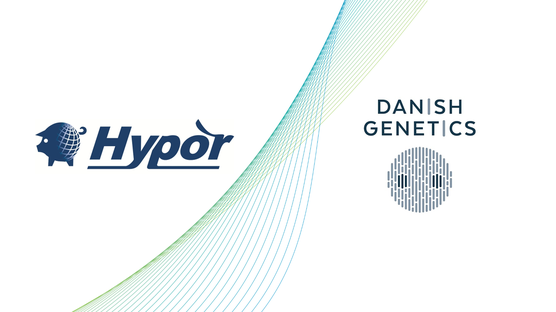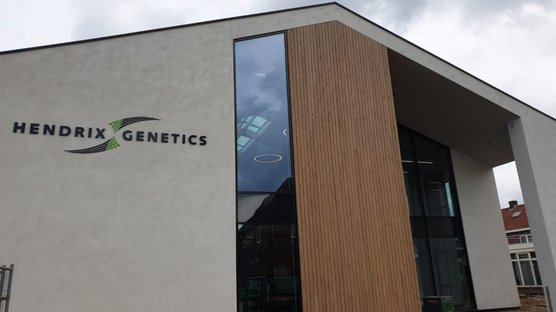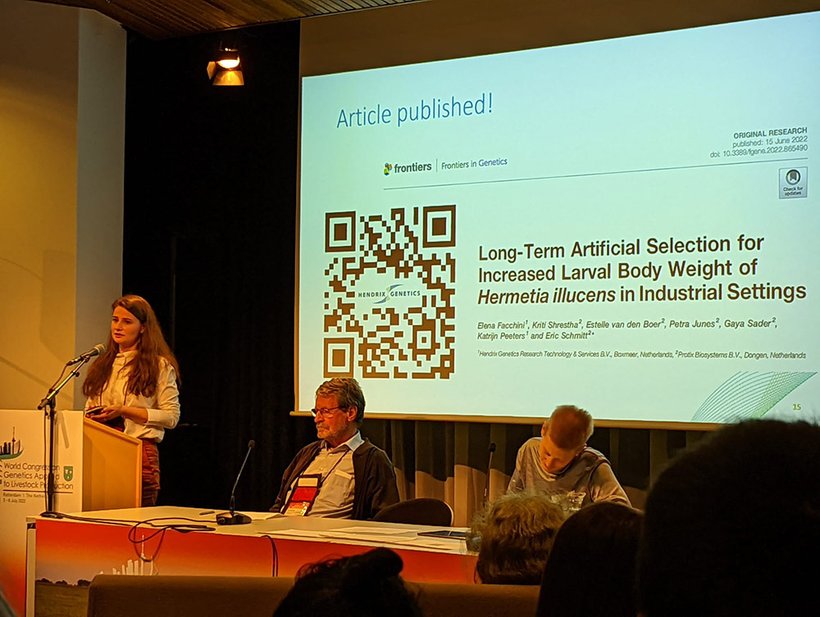
Published on July 19, 2022
Interview with Elena Facchini and Katrijn Peeters
In this interview, Elena Facchini and Katrijn Peters talk about breeding insects, including questions such as the sustainable character of insect breeding or the challenges for genetic improvement of insects.
"In 2013, I received my BSc degree in Biomolecular Sciences from the University of Trento, and in 2015 my MSc in Veterinarian Biotechnology from the University of Milan. In the same year, I enrolled in the Doctoral School of Veterinary and Animal Science at the University of Milan. Since my undergraduate studies, I have focused on the genetics of honeybees."
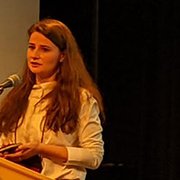
Right after my Ph.D. in 2018, I started working as an insect geneticist at Hendrix Genetics Research & Technology Center. In this role, I am developing breeding programs for farmed insects.
"In 2009, I received a double MSc degree in Animal Science from Wageningen University, specializing in both Animal Breeding and Genetics, as well as Quantitative Veterinary Epidemiology. After my MSc, I started a PhD at the Animal Breeding and Genomics Center of Wageningen University."

In 2014, I started working at the Research & Technology Center (RTC) of Hendrix Genetics as a Research Geneticist. In 2019, I gladly took on insect breeding in my project portfolio. In 2020, I became Team Lead Genetics and Genomics within RTC.
Why are we breeding insects?
Elena:
"The mass rearing of insects is an emerging and sustainable sector, and I believe it will be an essential protein source for the future. Up to now, insect producers have improved husbandry techniques. In contrast, the most common reared species have not been artificially selected yet. We know how genetics can play a role in improving production and the environmental impact of production. Consider laying hens, for example. An average laying hen in the world lays up to 350 eggs in her lifetime. With the breeding programs at Hendrix Genetics, we select the best of the best for every generation achieving improved results over the years. Hendrix Genetics hens can lay up to 500 first-quality eggs in their lifetime. It’s not hard to calculate the extra protein with even fewer resources needed. Imagine what insects will contribute to a more sustainable planet!"
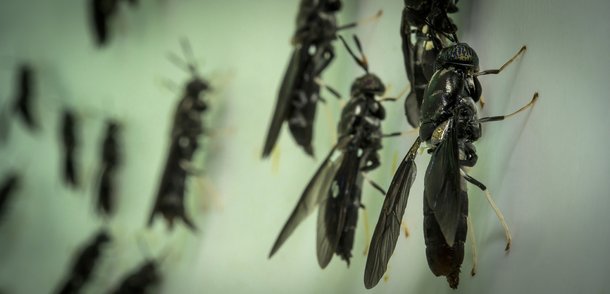
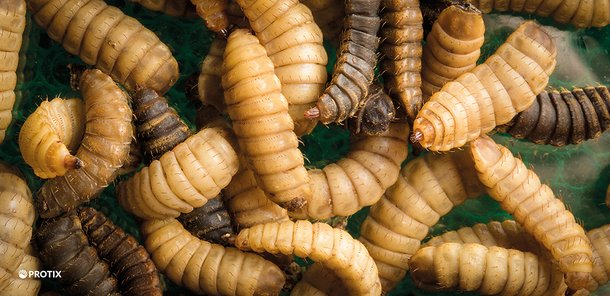

Katrijn:
"The insect industry is quite young, yet developing quickly, meaning that they are professionalizing fast, making sure that maximum output is being realized. They are taking very big steps towards finding the optimal conditions to farm insects (think of feed, humidity, temperature, etc.). Genetics has a role to play in maximising the output. Competing with other protein sources and making sure that a sustainable future is well underway, the industry now raises the question: What can genetics bring?"
What is the sustainable character of insect breeding?
Elena:
"Insects are considered a more sustainable source of protein than traditional animals, like beef meat. With insects, production requires less land use, meaning more protein per square meter. Less water is needed, less residual products from what you harvest, and an even more circular system since insects (like swine) can live on the waste streams. Also, when harvesting a cricket or a mealworm, you can keep the whole insect as is, and the process is far easier and cost-effective. With other protein sources, leftovers and waste are part of the game."
Katrijn:
"The outcome of our genetic improvement program in black soldier fly clearly showed that the insect farming industry can become even more sustainable."
What is the top 3 biggest challenges for genetic improvement of insects?
Elena:
"From a practical point of view - the short generation time in the Black Soldier Fly is a challenge. Measuring the traits and selecting the best animals need to be done quickly compared to other livestock. That, of course, is also an advantage. Progress goes much faster if a new generation is present shortly! Another significant challenge is the limited knowledge of basic biology, like pathologies or behaviors. Up to now, the Black Soldier Fly has no major pathologies reported, for example. Moreover, a lot has still to be discovered on the genetics of farmed insects."
Katrijn:
"We are used to individually identify every animal. For example, every turkey or chicken gets a wing band, pigs an ear tag, and every fish gets a pit tag. With insects, we're working with such small entities, that we currently can’t easily individually identify every animal. It doesn’t mean you cannot, because obviously if you put them in separate cups, you can. Nevertheless, with such big numbers, it makes it challenging.
Another challenge is today’s lack of knowledge of the biology of insects. Certain crucial knowledge on reproductive behaviour is missing. Things need to be explored, which makes insects an interesting and challenging field.
Also, from a genetics point of view, knowledge is limited. Heritabilities, genetic correlations...We are only now starting to understand the genetic architecture of certain traits.
To summarize: the biggest challenges are: traceability, lack of biology knowledge, and the general lack of knowledge on genetics."
Where are we 5 years from now?
Elena:
"We strive for more collaborations with new companies to support the global food challenge with high-quality animal genetics. Setting standards for sustainable animal breeding, including insect breeding, has a significant role in a circular economy."
Katrijn:
"Looking at different types of species, adding the most promising ones to our value chain. Also, we will move from single trait selection to multi-trait selection, like we do for other species. Selecting for body weight, feed conversation, liveability, all at the same time. As mentioned, we need further understanding on the genetic architecture to make this a success. As we develop our methodologies further, improving selections, adding different traits, we will find innovative ways to combine and progress."
Now we have these results, what does that mean for the global food challenge?
Elena:
"Improving efficiency means getting more out of the same starting materials with the same or fewer resources. Insects will make food and feed production more sustainable."
Katrijn:
"Working towards efficiency, less waste, less environmental pressure, and a more natural and sustainable way of producing, using and recycling our resources. The era for insect breeding has begun. The production of proteins can progress further. For human and animal consumption and a happy sustainable planet."
The strength of Hendrix Genetics
Katrijn:
"With our multispecies background and focus on sustainable animal breeding, we work towards a long-term breeding program with populations that thrive, improved welfare for people and animals, while reducing the impact on our environment. For that we use multi-trait selection, a sustainable mindset, the newest technologies and research, bright minds and much more.
Making high-quality animal genetics available that supports the global food challenge, and feeds the world population today and tomorrow. Anyone can select the biggest animal and move forward, but it’s about selecting for the long-term, being able to weigh in all aspects, and making sure we all thrive."

